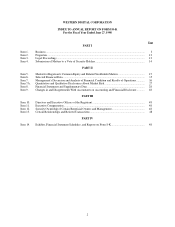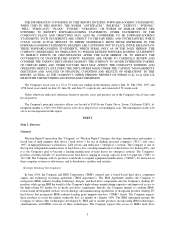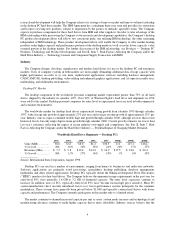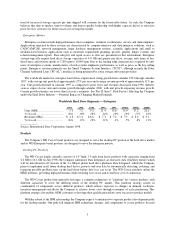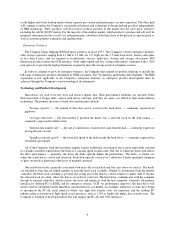Western Digital 1998 Annual Report Download - page 15
Download and view the complete annual report
Please find page 15 of the 1998 Western Digital annual report below. You can navigate through the pages in the report by either clicking on the pages listed below, or by using the keyword search tool below to find specific information within the annual report.
10
To be competitive, Western Digital must manufacture significant volumes of high quality hard drives at low unit
cost. One of the essential requirements for the Company to benefit from the IBM Agreement will be its ability to utilize
its own high-volume manufacturing technologies for products based upon IBM technologies, which historically have
not been developed for high volume production. The Company strives to maintain manufacturing flexibility, rapidly
achieve high manufacturing yields and acquire high-quality components in required volumes at competitive prices. The
critical elements of Western Digital's hard drive production are high volume, low cost assembly, and testing and
establishment and maintenance of key vendor relationships in order to create "virtual vertical integration." By
establishing partner relationships with many of its key strategic component suppliers, the Company believes it is able
to access "best-of-class" manufacturing quality without the substantial capital investment associated with actual
vertical integration. In addition, the Company believes that its virtual vertical integration model enables it to have the
business flexibility needed to select the highest quality low cost suppliers as product designs and technologies evolve.
Hard drive manufacturing is a complex process involving the assembly of precision components with narrow
tolerances and extensive testing to ensure reliability. The assembly process occurs in a "clean room" environment
which demands skill in process engineering and efficient utilization of the "clean room" layout in order to reduce the
high operating costs of this manufacturing environment. In 1998 the Company experienced decreases in manufacturing
yields as a result of tighter manufacturing tolerances associated with extending the use of thin film heads in higher
capacity drives as thin film technology reached its technical limits. With the completed transition to MR head
technology for desktop PC hard drives, the Company has recently increased its factory yields on desktop PC hard
drives to its historically high levels.
The Company produces hard drives in its three plants, two in Singapore and one in Malaysia. These plants have
responsibility for all hard drives in volume production, including manufacturing, purchasing, inventory management,
assembly, testing, quality assurance and shipping of finished units. The Company purchases most of the standard
mechanical components and micro controllers for its hard drives from external suppliers, although the Company has a
media manufacturing facility in Northern California which supplies a significant portion of its media requirements.
The Company's media manufacturing facility runs substrates, acquired from third party vendors, through various
manufacturing processes of layering, coating and lubricating in order to achieve the proper degree of final surface
smoothness. After conducting final quality assurance tests, the media plant delivers finished media to the Company's
overseas manufacturing facilities.
The Company continually evaluates its manufacturing processes in an effort to increase productivity and decrease
manufacturing costs. In order to address inventory oversupply, the Company has implemented production cutbacks in
its manufacturing facilities and is now carrying excess manufacturing capacity that must be addressed through
production increases or plant closure. The Company believes that more automated manufacturing processes may be
required in the future in order to be competitive in the hard drive industry and evaluates which steps in the
manufacturing process would benefit from automation and how automated manufacturing processes support the
Company's business plans.
For an additional discussion of manufacturing, see Part II, Item 7, Risk Factors Affecting the Company and/or the
Hard Drive Industry — Foreign Sales and Manufacturing Risks.
Research and Development
The Company devotes substantial resources to development of new products and improvement of existing
products. The Company focuses its engineering efforts on coordinating its product design and manufacturing processes
in order to bring its products to market in a cost-effective and timely manner. Research and development expenses
totaled $150.1, $150.2 and $203.7 million in 1996, 1997 and 1998, respectively. Research and development
expenditures included $24.5 million for microcomputer products in 1996 and approximately $22.0 million, primarily
related to the initiation of the IBM relationship, in 1998. The microcomputer businesses were sold in 1996. Recurring
research and development expenditures for hard drive products increased by approximately $24.6 million from 1996
to 1997 and by $31.5 million from 1997 to 1998.
For a discussion of product development, see Part II, Item 7, Risk Factors Affecting the Company and/or the Hard
Drive Industry — Rapid Technological Change and Product Development.




